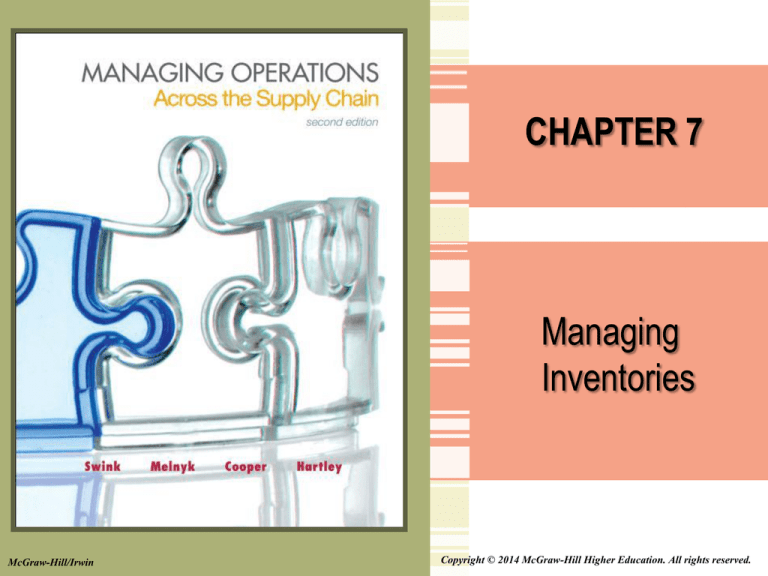
CHAPTER 7
Managing
Inventories
McGraw-Hill/Irwin
Copyright © 2014 McGraw-Hill Higher Education. All rights reserved.
Learning Objectives
LO7-1 Define the different types and roles of inventory
LO7-2 Explain the financial impact of inventory
LO7-3 Explain and compute measures of performance
LO7-4 Calculate inventory policy parameters to minimize
total acquisition cost
LO7-5 Determine the cost of a company’s service level
policy
LO7-6 Explain the advantages and disadvantages of
different inventory location strategies
LO7-7 Describe practical techniques for inventory planning
and management
7–2
Types of Inventory
Inventory: supply of items held to meet demand
Suppliers
Raw Material
Components
MRO
Maintenance, repair &
operating supplies
Work in
Process (WIP)
Finished
Goods (FGI)
Transportation
Distribution
LO7-1
Customers
7–3
Financial Impact of Inventory
Carrying (Holding)
Costs
• Opportunity cost
(including cost of
capital)
• Storage and
warehouse
management
• Taxes and
insurance
• Obsolescence,
spoilage, &
shrinkage
• Material handling,
tracking and
management
LO7-2
Ordering and Setup Costs
• Purchased items:
placing and
receiving orders
• Make items:
change-over
between items
Stockout Costs
• Lost sales or
customer loyalty
• Expediting
• Schedule
disruption
7–4
Measures of Inventory Performance:
Inventory Turnover
Inventory turnover: ratio of average inventory
on-hand and level of sales
= Cost of goods sold / Average inventory at cost
= Net sales / Average inventory at selling price
= Unit sales / Average inventory in units
With an annual cost of goods sold of $500M and
average inventory of $80M.
Inventory turns = $500/$80 = 6.25 turns
Example 7-2
LO7-3
7–5
Measures of Inventory Performance:
Days, Service Level, Stock outs
• Days of Supply: length of time operations can
be supported with inventory on-hand
Days of supply = Inventory/Daily demand
If inventory is 2M and daily demand is 25,000
day
Example 7-3
Days of supply = 2M/25,000 = 80 days
• Service Level: ability to meet customer
demand without a stock out
• Stock out: no inventory is available
LO7-3
7–6
Inventory Management Systems
• Independent Demand:
demand is beyond control of the
organization
• Dependent Demand: demand
is driven by demand of another
item
LO7-4
7–7
Continuous Review Model
• Continuous Review: inventory levels are
constantly monitored to determine when
to place a replenishment order
Units in
Inventory
Average
Inventory
Order Point
Time
LO7-4
Figure 7-1
7–8
Total Acquisition Costs
Total Acquisition Costs: sum of all relevant
annual inventory costs
– Holding costs: associated with storing and
assuming risk of having inventory
– Ordering costs: associated with placing
orders and receiving supply
TAC = annual ordering cost + annual carrying cost
LO7-4
7–9
Economic Order Quantity (EOQ)
• Economic Order Quantity (EOQ):
minimizes total acquisition costs; point at
which holding and orders costs are equal
• How much to order
D = Annual Demand
Co= Ordering cost
U = Unit cost
Ci = Holding cost
LO7-4
2 DC o
EOQ
UCi
7–10
Periodic Review Model
Order Interval: fixed time between inventory
review, on-hand level is unknown during this
uncertainty period
UP = OI + t
UP = Uncertainty period
OI = Order interval
t = average lead time
d = average lead time
z = standard deviations needed for service level
Q = d(UP) + zs ddup - A
s ddup= standard deviation of demand during the uncertainty period
A = inventory on hand
LO7-4
7–11
Single Period Inventory Model
• Single Period Inventory Model: items are
ordered once, and have little left over value
(newsvendor problem)
• Target Service Level: probability of meeting
demand
Cstockout Unit selling price Unit cos t
Coverstock Unit cos t Disposal cos t Salvage cos t
1 TSL Cstockout TSL Coverstock
LO7-4
Cstockout
TSL
Cstockout Coverstock
7–12
Managing Inventory
• Managing Cycle Stock: reducing lot sizes
• Managing Safety Stock: using ABC
analysis and reducing lead time
• Managing Locations: balance inventory,
lead time and service levels
• Implementing Inventory Models:
matching management system to specific
items
LO7-6
7–13
Inventory Information Systems and
Accuracy
• Global Trade Item Number
(GTIN): identification system
for finished goods sold to
Identification
consumers
Systems
• Part Number: unique identifier
used by a specific firm
Inventory
Record
Accuracy
LO7-7
• Cycle Counting: inventory is
physically counted on a routine
schedule
7–14
Managing Inventories Summary
1. There are multiple types of inventory
2. Inventory fulfills multiple roles
3. Inventory is an asset, and has multiple costs
4. An inventory policy determines how much and when
to order
5. Continuous systems monitor on-hand levels
6. Safety stock levels are linked with service levels
7. Periodic systems count inventory at specific
intervals
8. Number of storage locations impact inventory levels
9. Managers should work to reduce inventory levels
7–15




